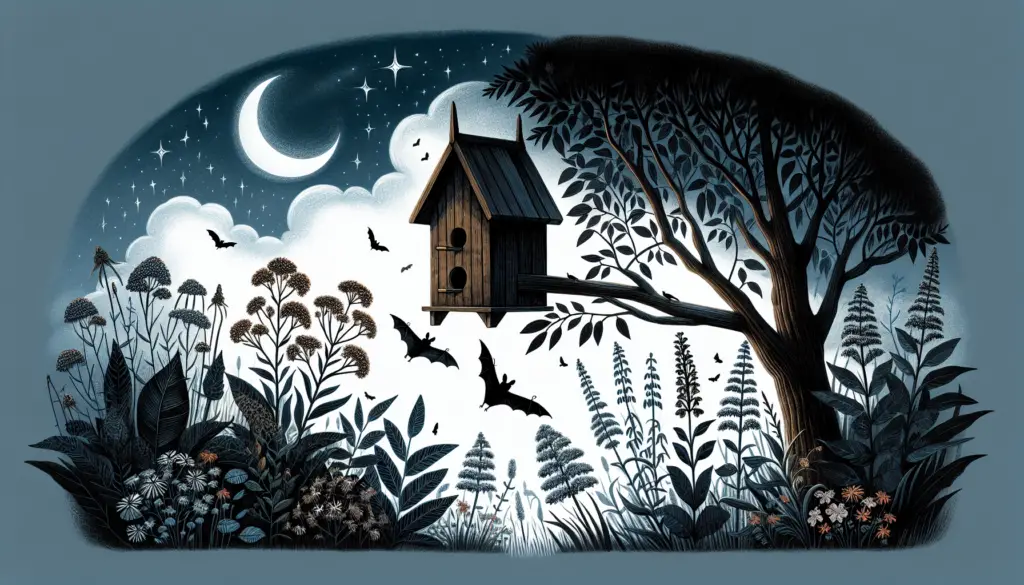Why Attract Bats to Your Yard?
Table of Contents
ToggleYou might be wondering why anyone would want bats hanging around their backyard.
The answer is simple: bats are incredible natural pest controllers.
These nocturnal creatures feast on mosquitoes, moths, and other insects that can be a nuisance.
By attracting bats, you’re reducing the need for chemical pesticides and creating a healthier environment.
Plus, it’s fascinating to watch them swoop and dive at dusk.
Choosing the Right Bat House
Picking the perfect bat house is the first step in welcoming these helpful critters.
Not all bat houses are created equal, so it’s important to select one that’s suitable for the species in your area.
For instance, the Greater Horseshoe Bat prefers larger roosting spaces.
Look for a bat house that’s at least 24 inches tall and 14 inches wide, with multiple chambers.
This size provides ample space for a colony to settle in.
Ensure the house is made of untreated wood and has rough surfaces inside for the bats to grip.
Optimal Placement of Your Bat House
Where you place your bat house can make or break your efforts.
Bats need warmth, so position the house where it gets at least six to eight hours of direct sunlight.
Facing it south or southeast is typically the best choice.
Mount the bat house at least 12 to 20 feet above the ground to keep it safe from predators.
Placing it on a pole or the side of a building is preferable over a tree, as trees provide too much shade and access for predators.
Keep the area below clear of obstructions to allow easy flight paths.
How to Make Your Bat House Inviting
Making the bat house appealing will increase the chances of bats moving in.
Painting the exterior with a non-toxic, dark-colored paint can help retain heat.
A temperature range of 85 to 100 degrees Fahrenheit inside the house is ideal for most bats.
Consider adding a water source nearby, like a birdbath or pond, as bats need water just like any other animal.
Avoid using bright lights near the bat house, as bats prefer darker environments.
Landscaping Tips to Attract Bats
Creating a bat-friendly environment extends beyond just the bat house.
Planting night-blooming flowers like evening primrose or moonflower can attract insects that bats love to eat.
Herbs like rosemary and thyme also attract nocturnal insects.
Maintaining a natural garden without excessive pesticides ensures a healthy food supply for bats.
Leaving dead trees or installing bat-friendly features can provide additional roosting options.
Providing a Water Source
Bats need a reliable water source for drinking and foraging.
If you have space, consider installing a small pond or fountain.
Even a simple birdbath can make a difference.
Make sure the water is clean and accessible.
This not only benefits bats but also enhances your garden’s ecosystem.
Avoiding Common Mistakes
There are some pitfalls to be aware of when attracting bats.
One common mistake is placing the bat house in a shaded or cool area.
Bats need warmth, so ensure it’s in a sunny spot.
Another mistake is expecting immediate occupancy.
It can take months or even years for bats to find and occupy a new bat house.
Patience is key.
Using Natural Pest Control
Bats are nature’s insect exterminators.
By attracting them, you’re reducing the number of pests in your yard.
This natural method is safer for your family and pets compared to chemical pesticides.
It’s also beneficial for the environment.
Embracing bats in your pest control strategy is a win-win situation.
Monitoring and Maintaining Your Bat House
Once your bat house is up, regular maintenance is important.
Check the house annually for wear and tear.
Ensure there are no wasp nests or blockages inside.
Keep an eye out for signs of occupancy, like guano below the house.
This will let you know if bats have moved in.
The Benefits of Bats in Your Ecosystem
Bats play a crucial role in maintaining a balanced ecosystem.
They help control insect populations, which protects crops and gardens.
Some species are even pollinators, aiding in the growth of plants and flowers.
By encouraging bats to live near you, you’re supporting biodiversity.
It’s a small step that makes a big difference.
A Closer Look at Bat Species You Might Attract
Different regions attract different bat species.
The Mexican Free-Tailed Bat is common in the southern United States.
They’re known for their agility and appetite for insects.
In some areas, you might attract the tiny Bumblebee Bat, the world’s smallest bat species.
Understanding the species in your area can help tailor your efforts.
Real-Life Product Recommendations
To make your bat-attracting journey easier, consider investing in a quality bat house.
The “Uncle Dunkel’s Two Chamber Bat House” is a popular choice among bat enthusiasts.
This bat house is handcrafted and meets the guidelines of Bat Conservation International.
Users praise its sturdy construction and high occupancy rates.
Its design ensures proper ventilation and temperature regulation.
Find This and More on Amazon
Another excellent option is the “OBC Certified Triple Chamber Bat House” by Amish Toybox.
This house offers more space for larger colonies.
Customers appreciate its weather-resistant materials and easy installation.
The triple-chamber design increases the chances of attracting bats.
Find This and More on Amazon
Don’t forget about maintenance tools like the “DEWALT 20V MAX XR Oscillating Tool.”
This tool is handy for any adjustments or repairs needed over time.
Its versatility makes it a great addition to your toolkit.
Find This and More on Amazon
Understanding Bat Behavior
Gaining insight into bat behavior can enhance your success.
Bats are creatures of habit and return to the same roosting sites.
By providing a comfortable environment, you’re more likely to keep them around.
Remember that bats hibernate during the winter, so don’t be alarmed if activity slows down.
In the spring, they’ll return and resume their nightly flights.
Addressing Common Concerns
Some people worry about bats carrying diseases like rabies.
While it’s true that bats can carry rabies, the risk is extremely low.
By avoiding direct contact and observing from a distance, you can enjoy their presence safely.
Bats are also not interested in getting tangled in your hair.
That’s just a myth.
Linking Bats to the Bigger Picture
Attracting bats isn’t just about pest control.
It’s about contributing to conservation efforts.
Bats face threats from habitat loss and diseases like white-nose syndrome.
By providing a safe home, you’re helping to support their populations.
This small action can have a significant impact.
Exploring More About Bats
If you’re curious to learn more, there’s a whole world of bat species out there.
The Vampire Bat, for example, has a fascinating reputation.
Though they have a creepy name, they’re actually quite interesting.
Another species, the Bulldog Bat, is known for its unique facial features.
Learning about different bats can enhance your appreciation for these creatures.
Connecting with Local Wildlife
Attracting bats can lead to more wildlife visits.
You might start noticing other animals like owls or even deer.
Speaking of deer, understanding deer habitat can also enrich your outdoor experience.
Creating a welcoming environment benefits the entire ecosystem.
It’s all interconnected.
Final Thoughts
Attracting bats to a bat house is a rewarding endeavor.
Not only do you get natural pest control, but you also contribute to wildlife conservation.
Remember to choose the right bat house, place it properly, and be patient.
With time and care, you’ll enjoy the many benefits that bats bring to your yard.
It’s a simple step with a big payoff.



